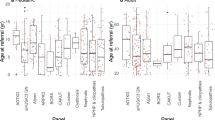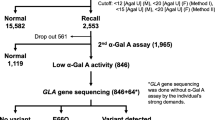Abstract
The advent of effective therapy for Fabry disease (FD) creates two challenges: (1) how do we identify individuals with the condition early in its natural history, and (2) how many people have the condition and require expensive therapy? Between 1981 and 2011, 17 new FD families were referred to the Northern Genetics Service in the North of England, the majority between 2005 and 2001. Since 2009 we have employed biochemical screening in dried blood spots from individuals with high risk phenotypes, such as left ventricular hypertrophy and unexplained renal failure, to identify four of the new index cases; and we have offered comprehensive cascade genetic testing to identify pre-symptomatic and symptomatic cases of FD in their 233 ‘at risk’ relatives. Overall, this combined approach identified a further 23 symptomatic cases of FD and 38 asymptomatic cases. The uptake of cascade genetic testing in this cohort was 48 %, which is similar to other inherited disorders for which there is an effective intervention. The minimum prevalence of GLA mutation in the North of England population at the end of 2011 was 1 in 40,800 and the prevalence of symptomatic FD was 1 in 64,600. Improved uptake of cascade genetic testing would increase these estimates to a maximum of 1 in 21,800 and 1 in 49,000 respectively. We suggest that any protocol for case identification should consist of targeted biochemical screening and coordinated cascade genetic testing.

Similar content being viewed by others
References
Brooks L, Lennard F, Shenton A et al (2004) BRCA1/2 predictive testing: a study of uptake in two centres. Eur J Hum Genet 12:654–662
Brouns R, Thijs V, Eyskens F et al (2010) Belgian fabry study. Prevalence of Fabry disease in a cohort of 1000 young patients with cerebrovascular disease. Stroke 41:863–868
Chamoles NA, Blanco M, Gaggioli D (2001) Fabry disease: enzymatic diagnosis in dried blood spots on filter paper. Clin Chim Acta 308:195–196
Christiaans I, Birnie E, Bonsel GJ et al (2008) Uptake of genetic counselling and predictive DNA testing in hypertrophic cardiomyopathy. Eur J Hum Genet 16:1201–1207
De Brabander I, Yperzeele L, Ceuterick-De Groote C, et al (2013) Phenotypical characterisation of alpha-galactosidase A gene mutations identified in a large Fabry disease screening program in stroke in the young. Clin Neurol Neurosurg. 115(7):1088–1093. doi:10.1016/j.clineuro.2012.11.003
Elliott P, Baker R, Pasquale F et al (2011) Prevalence of Fabry disease in patients with hypertrophic cardiomyopathy: the European Fabry disease survey. Heart 97:1957–1960
Forrest L, Delatycki M, Curnow L et al (2012) An audit of clinical service examining the uptake of genetic testing by at-risk family members. Genet Med 14:122–128
Germain DP (2010) Fabry disease. Orphanet J Rare Dis 5:30
Hwu W-L, Chien Y-N, Lee N-C et al (2009) Newborn screening for Fabry disease in Taiwan reveals a high incidence of the later-onset GLA mutation c.936 + 919 > A (IVS4 + 919G > A). Hum Mutat 30:1397–1405
Linthorst GE, Bouwman MG, Wijburg FA et al (2010) Screening for Fabry disease in high-risk populations: a systematic review. J Med Genet 47:217–222
MacDermot KD, Holmes A, Miners AH (2001a) Fabry disease: clinical manifestations and impact of disease in a cohort of 98 hemizygous males. J Med Genet 38:750–760
MacDermot KD, Holmes A, Miners AH (2001b) Fabry disease: clinical manifestations and impact of disease in a cohort of 60 obligate carrier females. J Med Genet 38:769–775
Morrison PJ, Harding-Lester S, Bradley A (2011) Uptake of Huntington disease predictive testing in a complete population. Clin Genet 80:281–286
Sanz J, Ramon y Cajal T, Torres A et al (2012) Uptake of predictive testing among relatives of BRCA1 and BRCA2 families: a multicenter study in northeastern Spain. Familial Cancer 9:297–304
Spada M, Pagliardini S, Yasuda M et al (2006) High incidence of later-onset Fabry disease revealed by newborn screening. Am J Hum Genet 79:31–40
Terryn W, Poppe B, Wuyts B et al (2008) Two-tier approach for the detection of alpha-galactosidase A deficiency in a predominantly female haemodialysis population. Nephrol Dial Transplant 23:294–300
Conflict of interest
OP has been funded by Genzyme Therapeutics Ltd to introduce DBS biochemical screening for FD in ‘at risk’ patient populations. The authors wish to thank Dr Heather Church for her advice during preparation of this manuscript and the clinicians involved in the investigation and care of the patients reported here.
Author information
Authors and Affiliations
Corresponding author
Additional information
Communicated by: Bridget Wilcken
Electronic supplementary material
Below is the link to the electronic supplementary material.
ESM 1
(DOC 79 kb)
Rights and permissions
About this article
Cite this article
Brennan, P., Parkes, O. Case-finding in Fabry disease: experience from the North of England. J Inherit Metab Dis 37, 103–107 (2014). https://doi.org/10.1007/s10545-013-9629-8
Received:
Revised:
Accepted:
Published:
Issue Date:
DOI: https://doi.org/10.1007/s10545-013-9629-8




